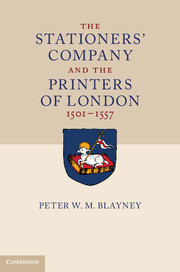Book contents
- Frontmatter
- Dedication
- Contents
- List of illustrations
- Preface
- Acknowledgements
- Permissions
- Conventions
- List of abbreviations
- 1 1357–1500
- 2 1501–1509
- 3 1510–1520
- 4 1521–1528
- 5 1529–1534
- 6 1535–1541
- 7 1535–1541
- 8 1542–1546
- Endnotes to Volume I
- 9 1547–1553
- 10 1553–1557
- 11 1554–1557
- 12 1501–1557
- APPENDIXES
- Bibliography
- Index of STC numbers
- General index
- References
3 - 1510–1520
Royal privilege and clerical scrutiny
Published online by Cambridge University Press: 05 November 2014
- Frontmatter
- Dedication
- Contents
- List of illustrations
- Preface
- Acknowledgements
- Permissions
- Conventions
- List of abbreviations
- 1 1357–1500
- 2 1501–1509
- 3 1510–1520
- 4 1521–1528
- 5 1529–1534
- 6 1535–1541
- 7 1535–1541
- 8 1542–1546
- Endnotes to Volume I
- 9 1547–1553
- 10 1553–1557
- 11 1554–1557
- 12 1501–1557
- APPENDIXES
- Bibliography
- Index of STC numbers
- General index
- References
Summary
New printers: John Rastell
When Henry VIII came to the throne in 1509, as a London industry printing was barely past its infancy. Rapid change was only to be expected, and the next few years brought significant innovations. The most inevitable was the setting up of printing houses by native-born Englishmen, of whom the first was John Rastell.
According to Pitseus in 1619, Rastell was born in London: ‘Ioannes Rastallus Londini in Anglia natus, & eiusdem vrbis ciuis ac typographus’. That was probably inspired by John Bale's more cautious description of 1548: ‘Ioannes Rastell, Anglus, ciuis ac typographus Londinensis’, but both writers disqualify themselves as experts by describing him as ‘ciuis’. It is true that gentlemen of the inns of court appear to have been tacitly allowed many of the privileges otherwise reserved for freemen. But being a barrister of the Middle Temple was not enough to make Rastell a citizen, and there is no evidence that he ever purchased the freedom. The earliest record of him is found in Coventry, where both his father and grandfather lived and held office, and there is no compelling reason to doubt that he was born there.
- Type
- Chapter
- Information
- The Stationers' Company and the Printers of London, 1501–1557 , pp. 121 - 178Publisher: Cambridge University PressPrint publication year: 2013



